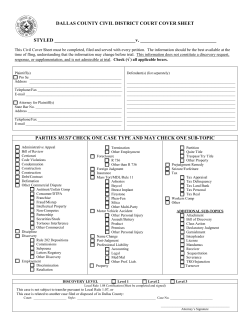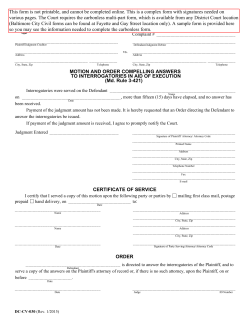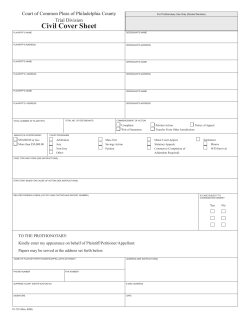
CLPU 81 - InBrief
COMMON LAW PRACTICE UPDATE 81 Section 3B Civil Liability Act 2002 (NSW) In White v Johnston [2015] NSWCA 18, the plaintiff underwent treatment by a dental surgeon, the defendant. At first instance assault and battery were made out. It was held that the defendant had no therapeutic purpose in performing the particular treatment on the plaintiff, nor had she proved that her patient’s had validly consented to the procedure. The first instance judge relied upon previous evidence of other instances of malpractice as tendency evidence. Reference was made to Dean v Phung [2012] NSWCA 223. At trial, substantial compensatory damages as well as $150,000 in exemplary damages were awarded. On appeal, it was held that where a medical practitioner is solely motivated by an unknown but non-therapeutic purpose, any consent from the patient is not valid and assault and battery is made out. The onus of proving such fraud lies on the patient. An intentional act is required, along with the intention to cause injury, in order for s 3B to displace the Civil Liability Act’s exclusion of exemplary damages. Evidence of earlier, other malpractice relating to fraud was wrongly admitted. That evidence lacked significant probative value for the purpose of showing that none of the dental work done had a therapeutic purpose. The discretion to order exemplary damages miscarried. Such damages only should have been ordered once compensatory damages had been determined. The discretion also miscarried because Dean v Phung was not comparable having regard the extent of work, seriousness of the harm, differing role of personal deterrence and the different financial position of the practitioner. As a result, the appeal was upheld and the matter remitted to the District Court for retrial confined to the question of negligence. Sections 5B and 5R Civil Liability Act 2002 (NSW) The plaintiff suffered personal injury and mental harm from an assault in Wright by his tutor Wright v Optus Administration Pty Ltd [2015] NSWSC 160. The plaintiff had been assaulted by Nathanial George in 2001, when George had thrown him off the fourth floor balcony of their workplace. At the time of the assault they were undertaking training given in the Optus call centre. The plaintiff and defendant barely knew each other, and had only met at the training course, the evidence however established that George had formed the urge to kill someone and ultimately fixated on the plaintiff. Although the murder attempt was foiled by the intervention of another person, the plaintiff had still suffered physical and psychological injuries. The plaintiff sued Optus for injury, arguing that the category of negligence discussed in TNT Australia Pty Ltd v Christie [2003] NSWCA 47 applied, so that the plaintiff owed a duty of care analogous to that of an employer to an employee, notwithstanding that the plaintiff was employed by a personnel contractor. Optus in turn sought contribution from the contractor. Before the incident, the plaintiff had approached George at the behest of Optus staff to ask whether anything was wrong, and had added “If you want me to help you, you have to tell me what’s wrong.” Optus argued that it owed no duty of care. However, there is a clear exception to the Modbury principle in respect of employment and employment-like situations. -2Campbell J found that the risk was foreseeable and not insignificant. The risk of harm involved permitting, allowing, authorising and encouraging the plaintiff to put himself in close physical proximity to George, whilst steps were being taken to remove him from the premises in circumstances where his conduct had raised real concern. George had already been unresponsive to other requests by Optus staff. Optus therefore breached its duty of care to the plaintiff in encouraging him to approach George, and, but for the failure of Optus to take reasonable precautions, the harm suffered by the plaintiff would not have occurred. There was no contributory negligence, and the personnel provider had no control over the situation and was not required to contribute to Optus. Damages were assessed at over four million dollars. Conclave of Experts – Uniform Civil Procedure Rules 2005 (NSW) The plaintiff moved for an order that a scheduled conclave of experts be postponed in Tinnock v Murrumbidgee Local Health District [2015] NSWSC 151. The plaintiff argued that this was necessary because it was alleged that the defendant local health district had recently adopted the position that it was not vicariously or otherwise liable for the conduct of a Visiting Medical Officer, who undertook or supervised surgery. Garling J noted that the UCPR requires the defence to clearly articulate the position that it was not vicariously or otherwise liable for the conduct of the VMO. This was not the case. The range of questions for the conclave seemed appropriate, even if the surgeon was later joined, so accordingly it was unlikely that the conclave conclusions would not go into evidence. Given the need for just, quick and cheap disposition of the real issues, Garling J decided against postponing the conclave. Child Sexual Abuse/Breach of Fiduciary Duty The plaintiff claimed equitable damages and exemplary damages for breach of fiduciary duty against the defendant in Pope v Madsen [2015] QCA 36. The first defendant was the plaintiff’s biological father. Her biological mother was named as second defendant. The first defendant applied to strike out or permanently stay the claim, as it did not disclose a cause of action known to Australian law. After the plaintiff’s parents separated in 1986 when she was about 8 years of age, the plaintiff continued to reside with the first defendant. She alleged that between 1977 and 1986 and then after 1986, the first defendant engaged in sexual acts which he deliberately allowed the plaintiff to witness. These acts included inappropriate touching of the plaintiff as well as substantial physical and mental abuse. That conduct included ejecting the plaintiff from the home and failing to provide her with a safe environment and adequate clothing. The trial judge refused to strike out the claim. The first defendant appealed. The plaintiff had alleged that the first defendant owed her fiduciary duties, including duties to care for her and protect her from harm, to secure her interests, to ensure she had adequate support and supervision and ensure she was not exposed to inappropriate conduct. Although the plaintiff submitted that none of the authorities directly concerned the relationship of parent and child, the Queensland Court of Appeal applied what was said by the High Court in Breen v Williams (1996) 186 CLR 71 (no fiduciary relationship between doctor and patient), and held the law does not support the existence of the course of action pleaded based on fiduciary duty. The action against the first defendant accordingly was struck out. -3- Liability of Councils/contractors The plaintiff injured his back whilst working as a roller driver in Central Darling Shire Council v Greeney [2015] NSWCA 51. The incident occurred at a remote location in NSW. The plaintiff was employed by GWI, which had been engaged by the Council to undertake road maintenance and repair. While attempting to couple a fuel tanker to the rear of a caravan, the plaintiff was injured after previously uncoupling the tanker from the rear of a 4wheel drive vehicle. The three vehicles were owned by GWI. No other GWI employee was at the scene, although one Council employee was present. At first instance, the trial judge found for the plaintiff, apportioning 60% responsibility to the Council and 40% to GWI. The Council appealed this finding. The Court of Appeal found that the primary judge had not erred in finding the Council had breached its duty. There were steps that could have been taken to eliminate or minimise the foreseeable risk of injury, the burden of taking them was not great and a reasonable person in the Council’s position would have taken those steps. Accordingly, causation was correctly established. The appeal was dismissed.
© Copyright 2025









